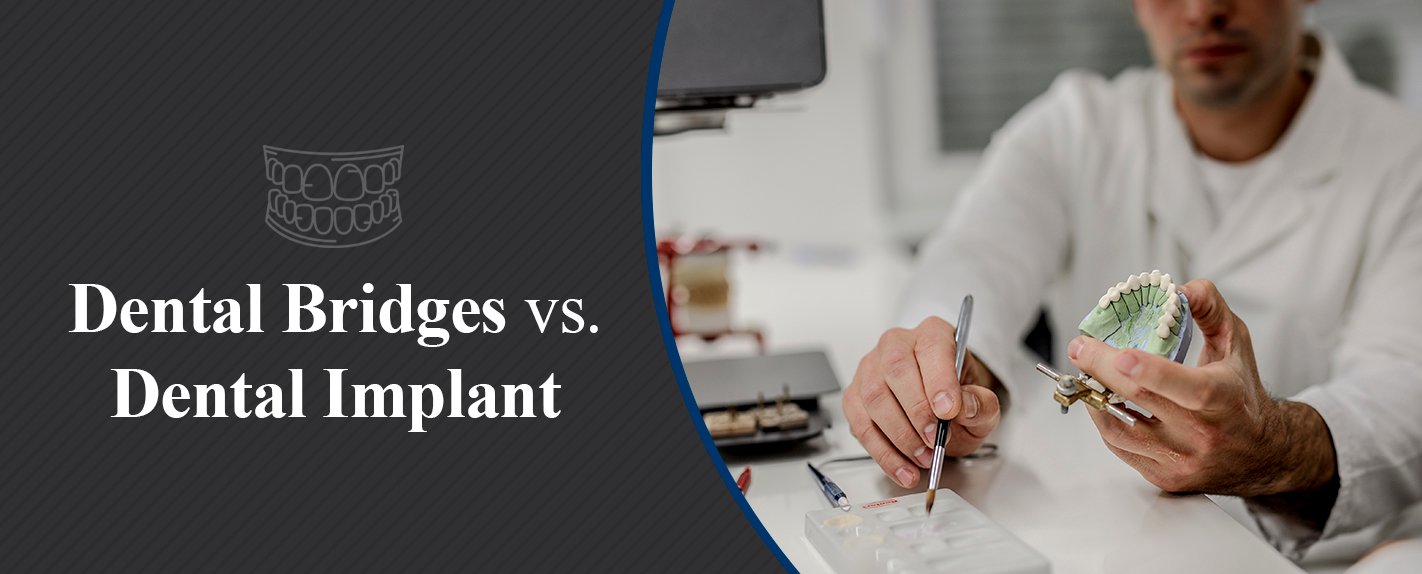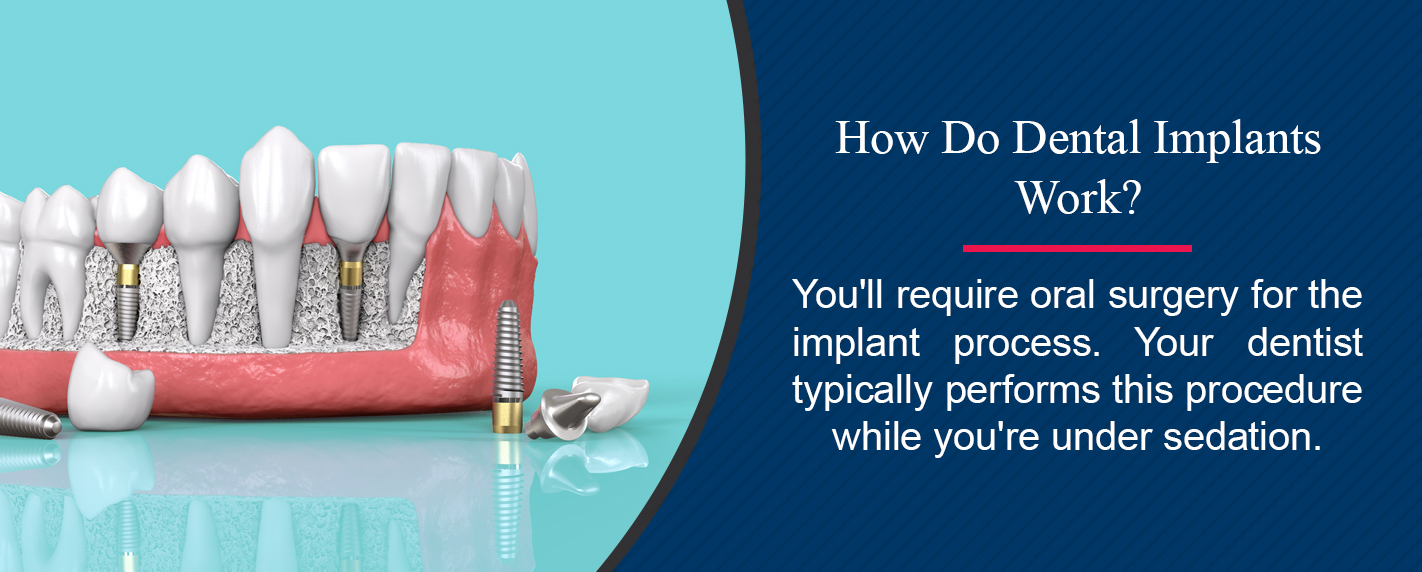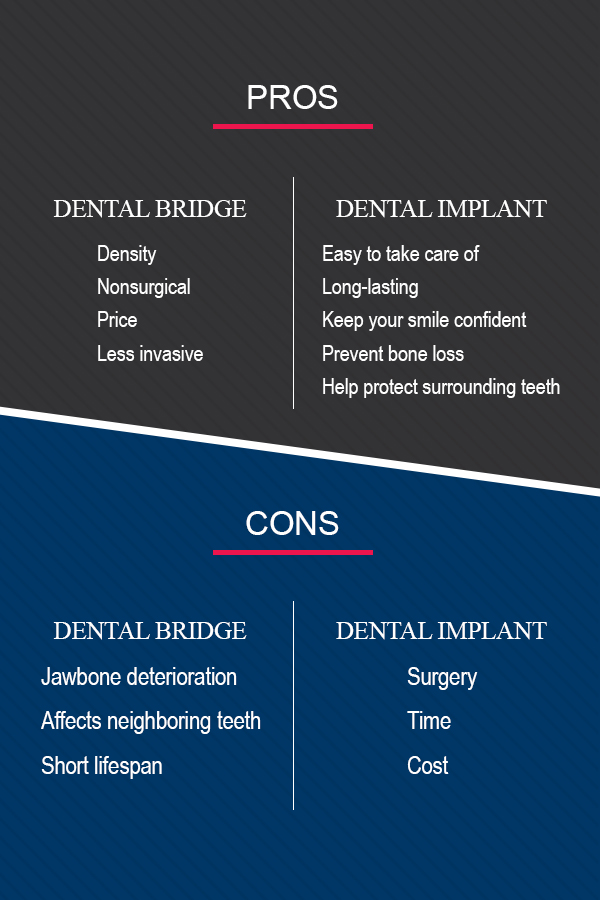May 1, 2019

“Should I get a bridge or implant?” That’s a common question many people ask themselves when it comes time for teeth replacements. Extracted or missing teeth can pose the risk of infection, but a quality replacement is a key to a healthy, beautiful smile. When it comes time to replace that missing tooth or teeth, your next question for your dentist will likely be, “What is the difference between a bridge and an implant?”
Let’s dive into that and go over considerations like types, aesthetics, cost, effectiveness, pros and cons and recovery of both.
In the past, the only option you had for a solution to a gap between teeth was a bridge. Today, people who have one or more missing teeth can still benefit from a dental bridge.
A dental bridge, as the name implies, literally “bridges” the space between teeth that results from a missing tooth. Therefore, the restoration needs anchoring to one or more neighboring teeth, which your dentist will have to file down so they can function as a support.
Bridges don’t replace your tooth root like implants. Instead, they use one or more of your surrounding teeth as a buttress for attaching a crown that fills the space of the missing tooth.
During your first visit to get a bridge, your dentist prepares the neighboring teeth. The preparation for this involves the dentist removing part of the enamel to recontour these teeth to allow room for the crown, which the dentist places over them.

Your dentist then takes impressions of the teeth to use as a model from which a dental technician will make the crowns, pontic and bridge in the lab. To protect your exposed gums and teeth while your bridge is under construction, the dentist will make you a temporary bridge.
Your dentist removes the temporary bridge during your second visit, and will check and adjust the new metal or porcelain bridge if necessary to ensure a proper fit. You may require multiple visits, so the dentist can check how the metal framework and bite fit. If you have a fixed bridge, the dentist might cement it temporarily in place for a couple of weeks to ensure it fits properly. They’ll then permanently cement the bridge after a couple of weeks.
A ceramic bridge can be attractive and largely unnoticeable. In some cases, the dentist might prefer a porcelain bridge over a dental implant, since it gives them more control over removing the small spaces between teeth that might not be aesthetically attractive if you have an implant.
The average lifespan of a bridge is around 10 years. A dental bridge involves at least three crowns attached to fill the missing tooth gap. However, this design can pose a challenge when it comes time to brush and floss, so the dentist will provide extra oral hygiene instructions.
If you follow the instructions carefully, you can keep your bridge clean and fresh and prolong its lifespan. Some dental bridge care tips are:
Ask the dentist how you can care for your bridge if you’re not sure, and return to their office regularly so they can check your bridge.
Part of your natural tooth is underneath the bridge, and normal wear could cause your bridge to fail over time. Your remaining tooth structure will continue to be vulnerable to gum disease and decay.
Numerous factors can affect the price, including:
The price also depends on which type of bridge you choose.
Dental implants are another solution for missing teeth. They’re an alternative option for many patients, and dental professionals often prefer them to dentures or even bridges.
If you have periodontal disease, an injury or another reason for a lost tooth or teeth, dental implants might be your best choice. A dental implant supports a crown with a titanium post that acts like a tooth root.
Your dentist will place the implant surgically, then fuse it to your jawbone, thus anchoring it into position. Having completed the fusing process, the dentist attaches an abutment to the post frame, which protrudes above your gumline, providing a space to screw or cement the dental crown into.
You’ll require oral surgery for the implant process. Your dentist typically performs this procedure while you’re under sedation.

During surgery, your dentist drills a small hole into your jawbone and screws the base carefully into your bone. They then place your gum over the dental implant so it can heal.
Once the implant base has healed efficiently, you’ll require a second surgery to fit a connector into the top of your dental implant. The dentist then will position the crown on top of this connector using a small screw and special dental cement.
Can you get an implant after a bridge? The answer is yes. Over time, a bridge can wear out and fail. It might not look as attractive as you hoped. Either way, you may wish to switch from a bridge to a dental implant to improve the aesthetics of your mouth.
Often, dental implants will offer the most pleasing result, since the dentist can make them look like natural enamel. In some cases, they may place an implant immediately after they extract your tooth, which preserves the natural level of bone and improves the appearance of your dental work.
Does a bridge or implant last longer? A dental implant is more durable than a bridge, which allows them to provide a lifetime of protection. The titanium metal cylinder of the implant is durable and incredibly resistant to gum problems and decay.
Dental implants are easier to maintain than bridges. Implants can replace individual teeth while not affecting your other teeth, which makes routine home hygiene easier. To ensure the implant’s longevity, keep it clean and free of damaging plaque and bacteria that could cause tissue infection around your implant, leading to failure.
A slimy, thin film of bacteria called biofilm builds up in your mouth. When you don’t remove this, it can cause a damaging inflammatory process known as peri-implantitis to develop, resulting in implant loss.
Your dental hygienist plays a significant role in keeping your implants free of disease. If they use traditional dental hygiene scalers on your natural teeth, they can scratch an abutment, crown or implant. Therefore, the hygienist will use special tools made of resins and plastics instead to clean thoroughly without causing any damage.
You also have an essential role to play in the success of your implants, which should motivate you to care for them properly. At home:
Preventing peri-implant disease is imperative to implant function and health, which is why an essential part of the success of your implant is how you care for it.
It can cost you between $3,000 to $4,500 to replace a single tooth with a dental implant, depending on factors such as where you live.
The cost of implants is typically higher than bridges, especially if you need more than one.
Also, implants may require adjunctive procedures like a bone graft or sinus lift to increase the amount of bone supporting the implants, which adds to the cost.
What is the difference between a bridge and an implant? Here’s a comparison of bridges and implants.
When it comes to bridgework vs. implants, individuals often use price as the deciding factor for their treatment option. And the cost can be deceiving in the case of dental bridges vs. implants.
Implants generally come at a higher cost than bridges, particularly if you require more than a single implant. Insurance usually covers dental bridges, but rarely implants.
The costs of dental bridges vary based on the type of bridge, the number of missing teeth, geographic location and more. Traditional bridges can range from $2,000 to $5,000.
If you don’t have dental insurance, you might choose the least expensive option, or you may consider signing up for a discount dental plan membership that offers discounted rates on these kinds of procedures.
The procedure for a dental bridge doesn’t take as long as the dental implant process, which involves creating a direct functional and structural connection between a load-bearing artificial implant’s surface and living bone. However, it can still be more invasive, since it requires the permanent alteration of surrounding teeth for supporting the bridge.
Your dentist can usually insert one implant in an hour or two, and the recovery time is relatively quick. Most individuals will feel good enough to return to work and other normal activities the next day. If you experience any discomfort after your procedure, over-the-counter pain medication should take care of it.
There’s also a short recovery time for a traditional bridge. You might experience some minor gum pain after the dentist cements your bridge into place. However, this typically goes away after several days. You might require a little time and adjustment in eating with the new dental bridge. You’ll want to avoid chewy or hard foods and cut softer foods into smaller pieces until you get used to it.
Following a bridge procedure, you should be able to chew and eat without issues, but you will need to change your dental care routine. No matter what type of bridge you have, you’ll have to clean under your false tooth.
When comparing dental bridges vs. dental implants, bridges are less durable. What lasts longer: a bridge, or an implant? Implants offer more extended protection — a lifetime. Bridges, on the other hand, have a lifespan of around 10 years. Implants also support jaw health. Your bone stays healthy and strong, which impacts both the shape of your face and oral health positively as you age. Implants naturally mimic the function and feel of a real tooth and often look better than bridges.
Let’s explore the strengths and weaknesses of dental bridges vs. implants.

Here are some advantages of dental bridges.
Here are some of the downsides of dental bridges.
Here are some advantages of dental implants.
Some of the downsides of dental implants are as follows.
For more information on bridges and implants, read our informational brochure. To learn more about which artificial teeth are better, reach out to us at Hiossen Implant by completing our online form or calling us at 888-678-0001. We specialize in providing effective, safe and simple-to-implement prosthetic products.